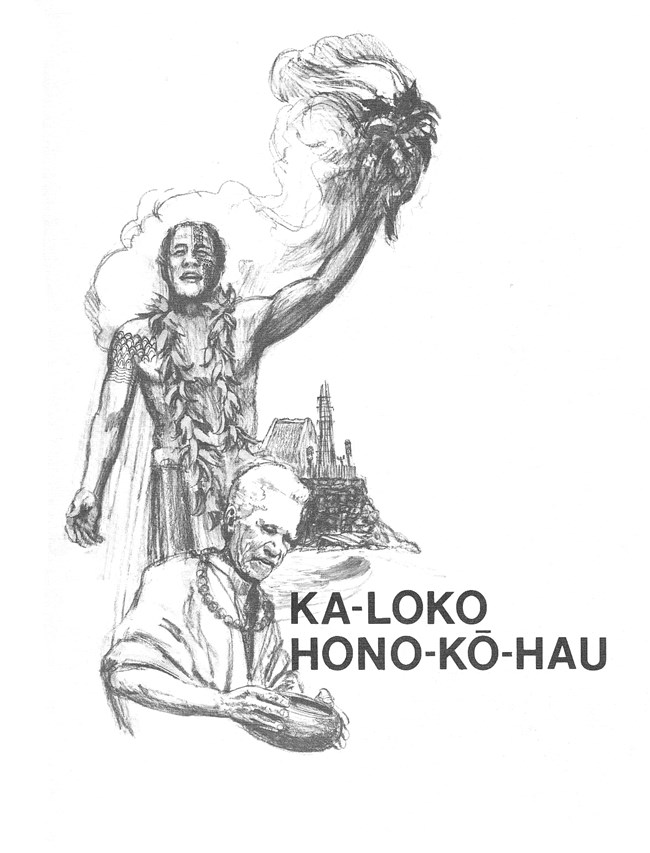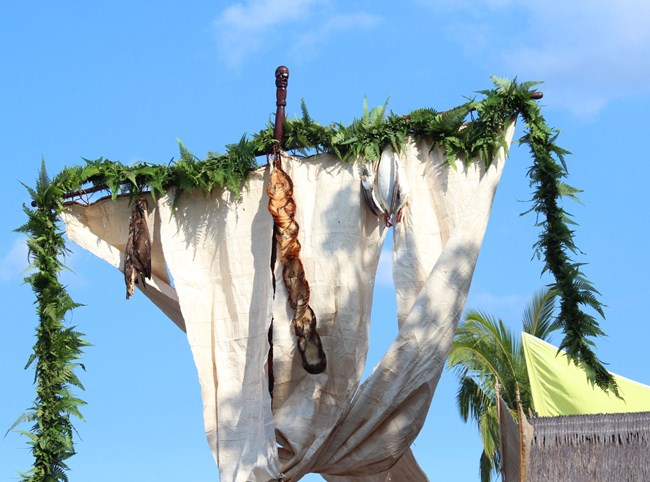|

The Spirit of Ka-loko Hono-kō-hau,1974, (pages 2 and 3.) 
NPS photo Within its approximately 1,200-acre boundary, the park protects the site of an ancient Hawaiian settlement, the coastal portions of five different ahupua‘a (traditional Hawaiian land divisions extending from the mountains into the sea), and a great concentration and variety of tangible and intangible resources that attest to the Hawaiians’ presence on the land. Kānaka maoli (Native Hawaiians) who once lived in this settlement possessed in-depth knowledge of their natural environment and demonstrated great ingenuity in adapting this seemingly inhospitable environment to their use. The people employed ingenious fishing and agricultural practices, and built large ponds to raise fish as a source of food. Some of the coastal pools provided an underground water source to support a settlement of people. The spirit of the po'e (people) and the knowledge of the kūpuna (elders) created a tradition of respect and reverence for the area. Among the park’s diverse resources are loko i‘a (two fishponds and a fishtrap that were used for food production), kahua (house site platforms), ki‘i pōhaku (petroglyphs), heiau (temples), graves, and a network of historic trails. As expressed in the Spirit Report, these resources are “not just a few token archeological representations of the Hawaiian culture, but the historic site of an entire community that existed as an entity within the boundaries of the ahupua‘a but tied as well to adjacent communities of similar structures. It is a stage upon which the Hawaiian way of life was first performed centuries ago.” This distinctively Hawaiian way of life persisted for centuries, but almost disappeared after European contact and settlement. Today Kaloko-Honokōhau National Historical Park provides opportunities to learn about Hawaiian culture and offers a much-needed venue for the practice and perpetuation of traditional skills and knowledge. The park’s rich natural abundance and diversity further draw people to this special place, where they may spot rare native plants and wildlife. The endangered ae‘o (Hawaiian stilt) and ‘alae ke‘oke‘o (Hawaiian coot) make their home in the ‘Aimakapā Fishpond. Several species of migratory waterfowl visit the park every year to overwinter at ‘Aimakapā Fishpond. Along the shoreline, local residents and visitors may watch for juvenile honu (Hawaiian green sea turtles) feeding in the shallows and migratory shorebirds foraging along the shore, or on occasion may encounter an ‘īlioholoikauaua (Hawaiian monk seal) basking on the beach. Vibrantly colored corals and fish are seen by those who explore the park’s waters offshore. Although Kaloko-Honokōhau National Historical Park is a place that all people may visit and appreciate, it has particular significance to Hawaiians. As expressed in the Spirit Report, the park provides an opportunity to “restore the cultural identity” of Hawai‘i. Through its preservation and management, the park enlarges “the horizons of people throughout the state, nation, and beyond.” Today the Hawaiian spirit is strong again and is celebrated and nurtured at Kaloko-Honokōhau National Historical Park. 
NPS
Visit our keyboard shortcuts docs for details
Fred Keakaokalani Cachola discusses the history of Kaloko-Honokōhau National Historical Park. |
Last updated: September 2, 2025
